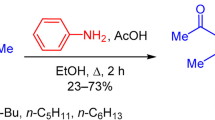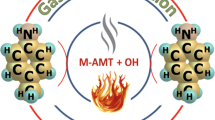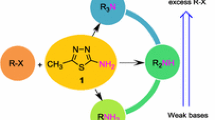Abstract
The reaction of N-nitro-O-(4-nitrophenyl)hydroxylamine (1) with conc. H2SO4 affords 4-nitropyrocatechol and that with conc. sulfonic acids (RSO3H where R = Me, CF3) affords 2-hydroxy-5-nitrophenyl-R-sulfonates in yields of 80–85%. These reactions are assumed to proceed through an intermediate (phenoxy)oxodiazonium ion [NO2C6H4O-N=N=O]+, which eliminates the N2O molecule to form the aryloxenium ion [NO2C6H4O]+. The latter reacts with acid anions at the ortho-carbon atom of the phenyl ring. The thermodynamical parameters of the elementary reactions resulting in the formation of the (phenoxy)oxodiazonium ion [NO2C6H4O-N=N=O]+ and aryloxenium ion [NO2C6H4O]+ were calculated in the B3LYP/6−311+G(d) study of the combined molecular system (nitrohydroxylamine 1 + [H3SO4]+). The reaction of nitrohydroxylamine 1 with aqueous solutions of strong acids (∼70% H2SO4, CF3SO3H) affords mainly 4-nitrophenol. It appears that the mechanism of this reaction does not involve the formation of the aryloxenium ion.
Similar content being viewed by others
References
M. S. Klenov, A. M. Churakov, O. V. Anikin, Yu. A. Strelenko, V. A. Tartakovsky, Izv. Akad. Nauk, Ser. Khim., 2009, 1895 [Russ. Chem. Bull., Int. Ed., 2009, 58, 2047].
A. H. Clemens, J. H. Ridd, J. P. B. Sandall, J. Chem. Soc., Perkin Trans. 2, 1984, 1667.
M. Ali, J. H. Ridd, J. Chem. Soc., Perkin Trans. 2, 1986, 327.
R. A. Abramovitch, G. Alvernhe, R. Bartnik, N. L. Dassanayake, M. N. Inbasekaran, S. Kato, J. Am. Chem. Soc., 1981, 103, 4558.
Y. Endo, K. Shudo, T. Okamoto, J. Am. Chem. Soc., 1982, 104, 6393.
A. D. Becke, J. Chem. Phys., 1993, 98, 5648.
C. Lee, W. Yang, R. G. Parr, Phys. Rev. B., 1988, 37, 785.
V. N. Solkan, V. B. Kazansky, Kinet. Katal., 2000, 41, 46 [Kinet. Catal. (Engl. Transl.), 2000, 41].
V. B. Kazansky, V. N. Solkan, PhysChem&ChemPhys., 2003, 5, 31.
NIST Standard Reference Subscription Database; http://www.nist.gov.
M. S. Klenov, M. O. Ratnikov, A. M. Churakov, Yu. A. Strelenko, V. A. Tartakovsky, Izv. Akad. Nauk, Ser. Khim., 2011, 523 [Russ. Chem. Bull., Int. Ed., 2011, 60, 536].
F. Arndt, in Organic Syntheses, V. 15, Wiley, New York, 1935, pp. 3–4.
P. K. Bhattacharyya, B. P. Dailey, J. Chem. Phys., 1973, 59, 5852.
N. P. Buu-Hoi, G. Saint-Ruf, M. Mangane, J. Het. Chem., 1972, 9, 691.
R. C. Cambie, G. R. Clark, S. L. Coombe, S. A. Coulson, P. S. Rutledge, P. D. Woodgate, J. Organomet. Chem., 1996, 507, 1.
Y. Ikeya, H. Taguchi, I. Yoshioka, Chem. Pharm. Bull., 1981, 29, 2893.
D. E. Ewing, Org. Magn. Reson., 1979, 12, 499.
G. Tomalin, M. Trifunac, E. T. Kaiser, J. Am. Chem. Soc., 1969, 91, 722.
Author information
Authors and Affiliations
Corresponding author
Additional information
Dedicated the 80-th anniversary of the academician of the Russian Academy of Sciences O. M. Nefedov.
Published in Russian in Izvestiya Akademii Nauk. Seriya Khimicheskaya, No. 11, pp. 1221–1232, November, 2011.
Rights and permissions
About this article
Cite this article
Klenov, M.S., Churakov, A.M., Solkan, V.N. et al. The formation of aryloxenium ion in the reaction of N-nitro-O-(4-nitrophenyl)hydroxylamine with strong acids. Russ Chem Bull 60, 2263–2274 (2011). https://doi.org/10.1007/s11172-011-0346-x
Received:
Revised:
Published:
Issue Date:
DOI: https://doi.org/10.1007/s11172-011-0346-x




